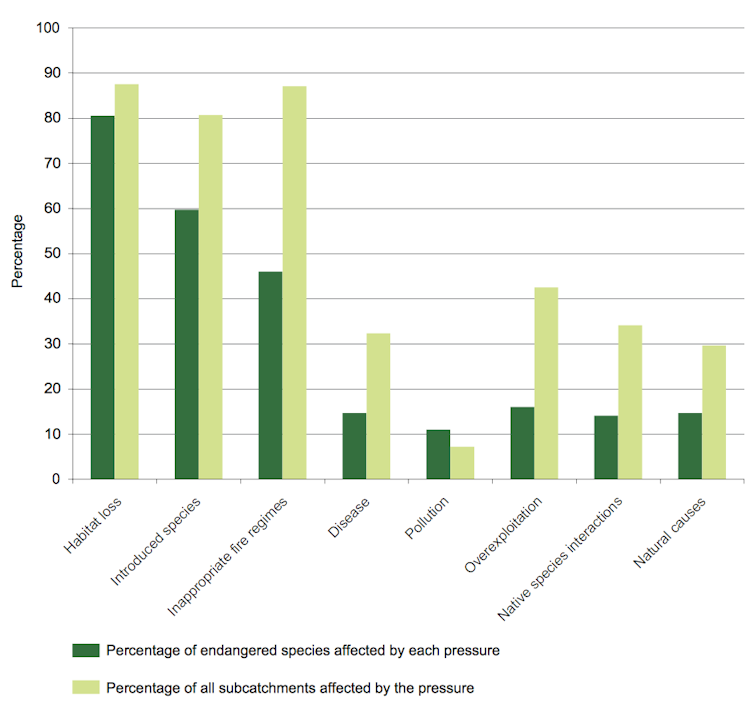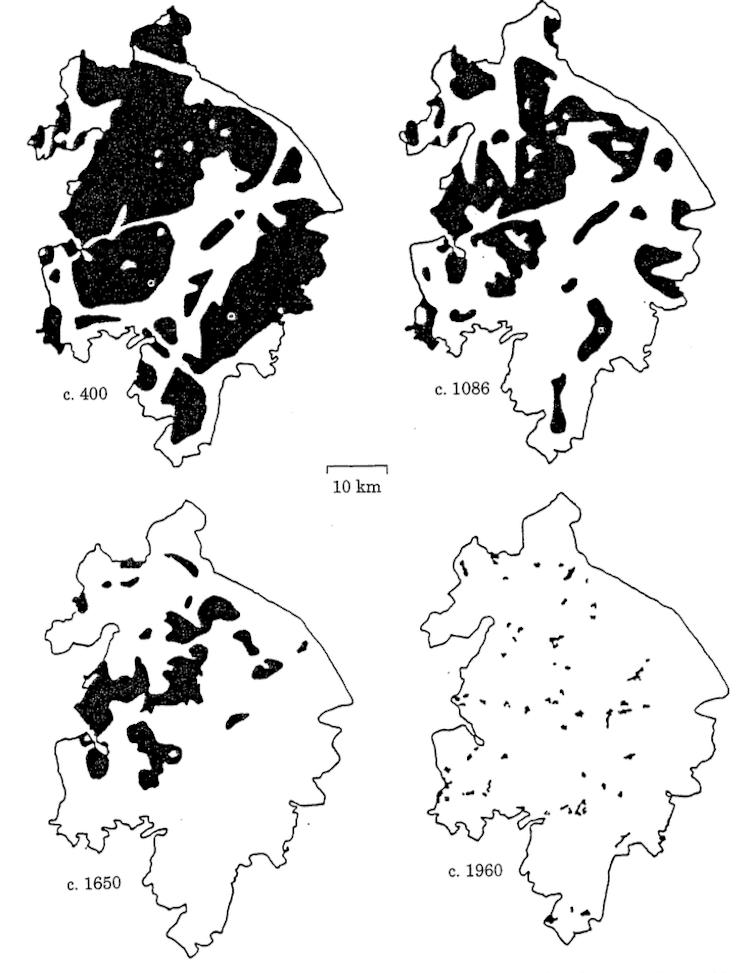Let’s get this straight, habitat loss is the number-one threat to Australia's species
- Written by Brendan Wintle, Professor of Conservation Ecology, University of Melbourne, University of Melbourne
Earlier this month, Australia’s outgoing Threatened Species Commissioner Gregory Andrews told ABC radio that land clearing is not the biggest threat to Australia’s wildlife. His claim caused a stir among Australia’s biodiversity scientists and conservation professionals, who have plenty of evidence to the contrary.
The ecologist Jared Diamond has described an “evil quartet” of threatening processes that drive species to extinction: habitat destruction; overhunting (or overexploitation); the presence of introduced species; and chains of linked ecological changes, including co-extinctions.
Read more: Australia’s species need an independent champion
In modern times we can add two more to this list. The first is catastrophic disease outbreaks, such as the chytrid fungus that has been instrumental in the catastrophic decline or extinction of almost 200 frog species, or the facial tumour disease that still threatens to wipe out Tasmanian devils in the wild.
The second is human-induced climate change, which appears to have caused one extinction in Australian Territories and is predicted to result in many more.
So the evil quartet has now become an evil sextet. It sounds ugly because it is. But does habitat loss through land clearing still top the list? The answer, in short, is yes.
Land clearing threat
According to an analysis of data from the International Union for the Conservation of Nature (IUCN), habitat loss is the number-one threat to biodiversity worldwide. Many more species are affected by processes such as logging and land clearing for agriculture and housing than by invasive species, disease or other threats.
 Number of amphibians impacted by key threats.
IUCN, Author provided
Number of amphibians impacted by key threats.
IUCN, Author provided
 Number of mammals impacted by key threats.
IUCN, Author provided
Number of mammals impacted by key threats.
IUCN, Author provided
Habitat loss is the top threat here in Australia too, an assessment that is backed up by the federal government’s State of the Environment Reports in 2011 and 2016.
 Pressures affecting species on Australia’s list of nationally threatened species.
State of the Environment Report 2011, Author provided
Pressures affecting species on Australia’s list of nationally threatened species.
State of the Environment Report 2011, Author provided
Compared with the rest of the world, Australia’s introduction of feral predators such as cats and foxes has had a devastating impact on iconic small mammals such as bilbies, and birds such as night parrots. Nationally, we invest a large amount of resources (relative to other threats) in creating predator-proof havens for threatened animals to keep feral predators out of key areas.
But despite this, habitat loss and land clearing pose an even bigger threat to animals and plants alike. It is the single biggest factor adding to Australia’s list of threatened species list, especially given the recent return to record-breaking land clearing rates.
Interacting threats
Of course, the evil sextet do not operate independently; they gang up, often with devastating results. The joint impact of two threats is often larger than the sum of its parts. Habitat destruction is the gang leader that joins forces with other threats to accelerate the slide to extinction.
When habitats are intact, large and in good condition, the species that depend on them are much better equipped to withstand other threats such as bushfires or invasive species. But as habitat is destroyed and chopped into smaller fragments, species’ populations become smaller, more isolated, and more vulnerable to predation or competition.
Larger populations of animals and plants also generally have larger gene pools, making them more able to adapt to new threats before it’s too late. Small populations, on the other hand, are sitting ducks.
You can see where this is heading. It’s all about habitat loss, because habitat loss makes all other threats more acute.
 Classic depiction of habitat fragmentation in Warwickshire between 400 AD and 1960.
Wilcove et al. Cons. Biol. (1986), Author provided
Classic depiction of habitat fragmentation in Warwickshire between 400 AD and 1960.
Wilcove et al. Cons. Biol. (1986), Author provided
The political landscape
Habitat loss is a polarising political issue, which makes it hard to legislate against. Most habitat is lost through land clearing for agriculture and urban development.
The quality and effectiveness of land clearing policy and legislation in Australia has risen and fallen like the tide over the past four decades. After being the world’s largest land clearing jurisdiction behind Brazil in the post-war era, the Beattie government in Queensland introduced hugely improved land-clearing laws in the mid-1990s.
But under the Newman government, Queensland resumed its world leadership in habitat destruction. While Queensland may be the most extreme example, every Australian state and territory has witnessed similar policy uncertainty over the decades. Meanwhile, no federal environment minister has made significant inroads into the problem since the establishment of the 1999 Environment Protection and Biodiversity Conservation Act.
Read more: More sightings of an endangered species don’t always mean it’s recovering
Reducing the impact of land clearing is not a job for a fainthearted politician, given the likely objections from the powerful agriculture and development lobbies.
The federal government’s Threatened Species Strategy and Action Plan provided some excellent initiatives to shield our species from some threats, but action to reduce habitat loss is notably absent. The number-one cause of extinctions has simply not been addressed.
Of course, the outgoing Threatened Species Commissioner is right to acknowledge the impact that feral cats and foxes. But I hope that whoever next takes on the role will be prepared to deliver an unambiguous message about the biggest threat to our plants and animals, and to outline a strong vision for how we can address it.
Authors: Brendan Wintle, Professor of Conservation Ecology, University of Melbourne, University of Melbourne



